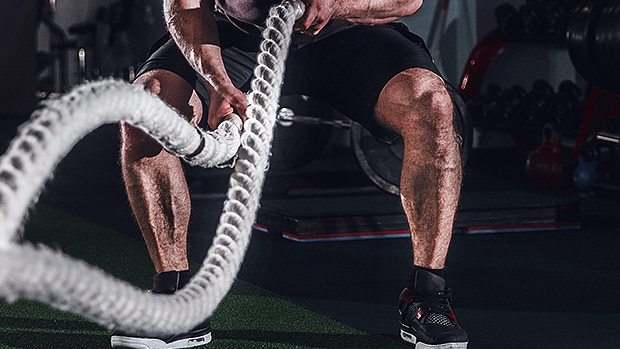If you're like a lot of lifters, you do your weights and then dutifully head over to the treadmills or bikes to put in some obligatory work for your ticker. It's the exercise equivalent of eating your vegetables, doing the dishes, cleaning up your room, or changing your dad's diapers because of that backhoe accident and it's your job to take care of him.
It's dreary stuff, but you do it because you have to, right? Well, I'm here to tell you that you don't have to do cardio after a workout.
In fact, you shouldn't do it. The next time you finish your weight workout, walk by all those sad people with their arms flailing, feet stomping, and saggy glutes wobbling and give them all the finger while shouting "Sayonara, losers!" because you're through with all that happy horseshit.
You're done with it because there's an overwhelming amount of research that tells us that doing cardio after a workout impedes strength and hypertrophy gains, in some cases negating them entirely.
There are a surprisingly large number of studies on the subject of if and when to combine weight training with cardio. Rather than drone on about the specifics of a few of them, here are the highlights:
- Tomiya and his fellow Japanese researchers tracked some lifters for 8 weeks. They found that those who did 30-minute periods of moderate-intensity cycling right after arm-resistance training only increased their biceps' size by 5%. A second group of lifters waited until the day after lifting to do moderate-intensity cycling and they increased the size of their biceps by 12.1%.
- Oddly, both groups gained the same amount of strength. That's a bit of an anomaly though, since most similar studies show that combining resistance training with stationary cycling show that both muscle size and strength suffered equally.
- Doleazl and Potteiger compared whole-body resistance training and lower-body endurance training over the course of 8 weeks. When trainees rode the exercise cycle after strength training, their increases in bench press strength were a lot less than with resistance training alone (12% compared to 24%).
- Robineau et al. compared the results of 0, 6, or 24-hour rest periods separating resistance training (RT) and endurance training over a 7-week period. The 0 and 6-hour intervals between RT and cycling led to lower adaptations of upper- and lower-body strength and hypertrophy when compared to the strength-training only group.
- Wilson and his colleagues found that concurrent resistance and endurance training done on the same day resulted in a reduced size-effect on muscle hypertrophy (0.80 vs. 1.06), strength (1.28 vs. 1.36), and power (0.36 vs. 0.47).
- Cantrell et al. compared the chronic effect of concurrent strength and sprint interval training on muscle strength and hypertrophy. The group found that doing cardio concurrently with lifting was fine, as long as the lifting and cardio occurred on separate days.

There are at least a couple of theories as to why doing weights and cardio one after another, on the same day, doesn't pay off in terms of muscle size and/or strength:
- If both resistance training and cardio worked the same muscles (e.g., riding the stationary bike after doing squats), the muscle might receive disparate signals, with one saying to increase muscle protein synthesis and the other instructing the muscle to give birth to more mitochondria.
- If resistance training and cardio worked different muscles, you might experience reduced phosphocreatine recovery in the resistance-trained muscle. The blood that's needed for the recovery of phosphocreatine is diverted to the muscles involved in cardio, in effect robbing Peter to pay Paul.
Done regularly over time, it might lead to reduced hypertrophy.
Clearly, doing cardio or "metabolic" work after doing resistance training is a fool's errand – a skinny fool's errand. If your goal is to build muscle and/or strength and you're also interested in maintaining cardiovascular health (or increasing your metabolic conditioning), ride the stationary bike or run the treadmill on separate days.
If that isn't possible because you're on a 6-on, 1-off split of some kind, or your circumstances just won't allow it, go ahead and lift weights and do cardio on the same day, but try to separate the two activities by at least 8 or more hours.
- Cantrell G.S. et al. "Maximal strength, power, and aerobic endurance adaptations to concurrent strength and sprint interval training," European Journal of Applied Physiology 114 ,2012, 763-771.
- Docherty, D et al. "A Proposed Model for Examining the Interference Phenomenon Between Concurrent Aerobic and Strength Training," Sports Med 2000, Dec;30(6):385-94.
- Dolezal B.A. et al. "Concurrent resistance and endurance training influence basal metabolic rate in nondieting individuals," Journal of Applied Physiology (1998) 85, 695-700.
- Robineau J. et al.. "Specific Training Effects of Concurrent Aerobic and Strength Exercises Depend on Recovery Duration," Journal of Strength and Conditioning Research (2016) 30, 672-683.
- Shigeto Tomiya et al. "Moderate Intensity Cycling Exercise after Upper Extremity Resistance Training Interferes Responses to Muscle Hypertrophy but Not Strength Gains," Journal of Sports Science and Medicine, 2017, 16, 391-395.
- Wilson J.M. et al. "Concurrent training: a meta-analysis examining interference of aerobic and resistance exercises," Journal of Strength and Conditioning, 2012, Research 26, 2293-2307.





